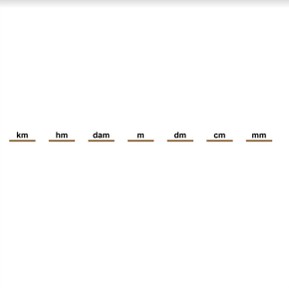
Knowing the metric measuring system (length)
Students learn the different measures in the metric measuring system.



8,000 schools use Gynzy
92,000 teachers use Gynzy
1,600,000 students use Gynzy
General
Students learn what the structure of the metric system is and what the underlying relationship is between the different units.
Common core standard(s)
CCSS.Math.Content.4.MD.A.1
Learning objective
Students will be able to describe what the metric system for length is and understand the relationship between the different units.
Introduction
Show several images. Ask the class which length measurement belongs with which image and drag the length measurement to the accompanying image.
Instruction
Explain that there are different metric measurements of length and name them. Then the students must state what the abbreviations stand for. Students must also think of an example of each length measurement. Say that you can use a mnemonic to help remember the order of the metric system of measuring length. The one we suggest is "King Henry's Dog Makes Delicious Chocolate Milk" but you may also have another that you prefer. Have the students determine what comes before and after the given measurement of length. Explain that with the metric system, you can take steps from one length measurement to another. If you take one step to the left, you divide by 10. The measurement becomes 10 times smaller. You can also take steps in the other direction. If you take one step to the right, then you multiply by 10. The measurement becomes 10 times larger. Have the students practice determining how many steps they need to take between the length measurements. There are various length measurements, along with different length measurements to which the students must convert. Next there are several statements, which the students need to determine whether they are true or false. You may have the students draw out the metric system, so that they can count the steps and determine whether the statement is correct. Then the students must make the metric system themselves. Drag the elements of the metric system to the correct location and put arrows with ÷10 and x10 in the right places.
To check whether students understand the metric system, you can ask the following questions:
- What do hm and dam mean?
- How many steps do you take when you go from decimeters to decameters? Do you need to divide or multiply?
- How many steps do you take when you go from millimeters to meters? Do you need to divide or multiply?
Guided practice
The students first practice determining the size of one step using the metric system. Next they must state whether a statement is true or false. Then they have to put the sizes in the correct order.
Closing
You discuss with the students again that it is useful to know the metric system, so that you can use it to convert to different length measurements. You check if the students understand the metric system by having them answer how large the step is from one size to another and whether they need to multiply or divide to get there.
Teaching tips
When students have difficulty with the metric system, you can give them the metric system diagram, where you add arrows for ÷10 and x10.
Instruction materials
You may print out a metric ruler.
The online teaching platform for interactive whiteboards and displays in schools
Save time building lessons
Manage the classroom more efficiently
Increase student engagement
Discover more!
About Gynzy
Gynzy is an online teaching platform for interactive whiteboards and displays in schools.
With a focus on elementary education, Gynzy’s Whiteboard, digital tools, and activities make it easy for teachers to save time building lessons, increase student engagement, and make classroom management more efficient.



